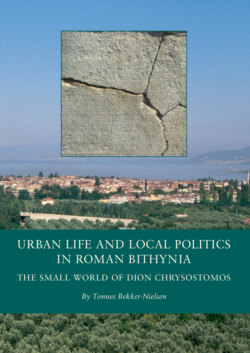Читать книгу Urban Life and Local Politics in Roman Bithynia - Tonnes Bekker-Nielsen - Страница 7
На сайте Литреса книга снята с продажи.
Urban rivalries
ОглавлениеThe agôn of man and his neighbours in the agora and other public spaces was paralleled at the collective level, where cities battled to maintain and reinforce their position vis-à-vis their neigbouring communities. Though the stakes were essentially the same, the arena was different. The province was no face-to-face environment: behaviour and actions counted for less, titles and tangible status markers for more. To enjoy the special favour of the ruler, the Roman governor or the emperor himself was important. So was the status of a city within the formal administrative hierarchy of the province. Monuments and great public buildings, too, played their role, but perhaps less for their own value as for the means to an end: the maintenance of status in the eyes of the ruling power. In fact, it is striking how often the city’s place within the agôn appears defined by its relation to the ruling power and its representatives. The rhetor Dion ridicules his fellow Prusans for wanting to preserve an old smithy whose dilapidated condition brings shame on the community on the occasion of the governor’s visit, while his opponents claim that Dion has not done enough to win the emperor’s favour for Prusa, which in that respect is far behind Smyrna.9 Among the visible expressions of the city’s high standing with the Roman authorities were honorific titles, above all that of mêtropolis and “first city within the province”. The sometimes extreme nature of the urban agôn is illustrated by the persistent rivalry between Nikomedia and Nikaia, continually competing for titles and honours (below, p. 47-48).
The fields of religion and education provided complementary arenas for the urban agôn. In 29 BC, Nikaia won for herself the imperial cult of the “Romans” in the province, while Nikomedia became home to that of the peregrines, i.e. the koinon. In the mid-fourth century AD, Libanios was enticed away from Nikaia by the offer of a teaching post in Nikomedia. At the council of Chalkedon in 451, the bemused delegates spent a whole day listening to bishop Eunomios of Nikomedia and his colleague, Anastasios of Nikaia, disputing the ecclesiastical jurisdiction over the parish of Basilinopolis.10
To some degree, Roman domination acted as a stabilising factor. Jealousy and enmity between cities could not be eliminated and indeed might be exploited in the interests of Rome, but at least they could be restrained. Further, the provincial law of Pompey the Great established a minimum age and a census threshold for the city councils, ensuring that urban politics would henceforth be dominated by adult property-owners, the “middle” class so dear to the theories of Aristotle. As we shall see, the census also had the useful side-effect of “compartmentalizing” the political arena and putting a brake on social mobility, and thus on conflict potential, within the city.
